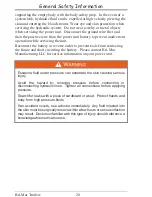
Tire Safety Information
Bri-Mar
28
•
Calculating total and cargo capacities with varying seating
configurations including quantitative examples showing /
illustrating how the vehicles cargo and luggage capacity
decreases as combined number and size of occupants’ increases.
This item is also discussed in Section 3.
•
Determining compatibility of tire and vehicle load capabilities.
•
Adverse safety consequences of overloading on handling and
stopping on tires.
3.1
T
RAILER
T
IRE
I
NFORMATION
Trailer tires may be worn out even though they still have plenty of tread
left. This is because trailer tires have to carry a lot of weight all the time,
even when not in use. It is actually better for the tire to be rolling down
the road than to be idle. During use, the tire releases lubricants that are
beneficial to tire life. Using the trailer tires often also helps prevent flat
spots from developing.
The main cause of tire failure is improper inflation. Check the cold tire
inflation pressures at least once a week for proper inflation levels. “Cold”
means that the tires are at the same temperature as the surrounding air,
such as when the vehicle has been parked overnight. Wheel and tire
manufacturers recommend adjusting the air pressure to the trailer
manufacturer’s recommended cold inflation pressure, in pounds per
square inch (PSI) stated on the vehicle’s Federal Certification Label or
Tire Placard when the trailer is loaded to its gross vehicle weight rating
(GVWR). If the tires are inflated to less than the recommended inflation
level or the GVWR of the trailer is exceeded, the load carrying capacity
of the tire could be dramatically affected. If the tires are inflated more
than the recommended inflation level, handling characteristics of the tow
vehicle/trailer combination could be affected. Refer to the owner’s
manual or talk to your dealer or vehicle manufacturer if you have any
questions regarding proper inflation practices.
Tires can lose air over a period of time. In fact, tires can lose 1 to 3 PSI
per month. This is because molecules of air, under pressure, weave their
way from the inside of the tire, through the rubber, to the outside. A
drop in tire pressure could cause the tire to become overloaded, leading
Trailers
Содержание DT508LP
Страница 28: ...General Safety Information Bri Mar 22 Figure 2 2 Gooseneck Safety Warning Label Locations Trailers...
Страница 144: ...Electrical Drawings Bri Mar 138 Trailers...
Страница 145: ...Bri Mar 139 9 ELECTRICAL DRAWINGS Trailers...
Страница 146: ...Bri Mar 140 Trailers...
















































